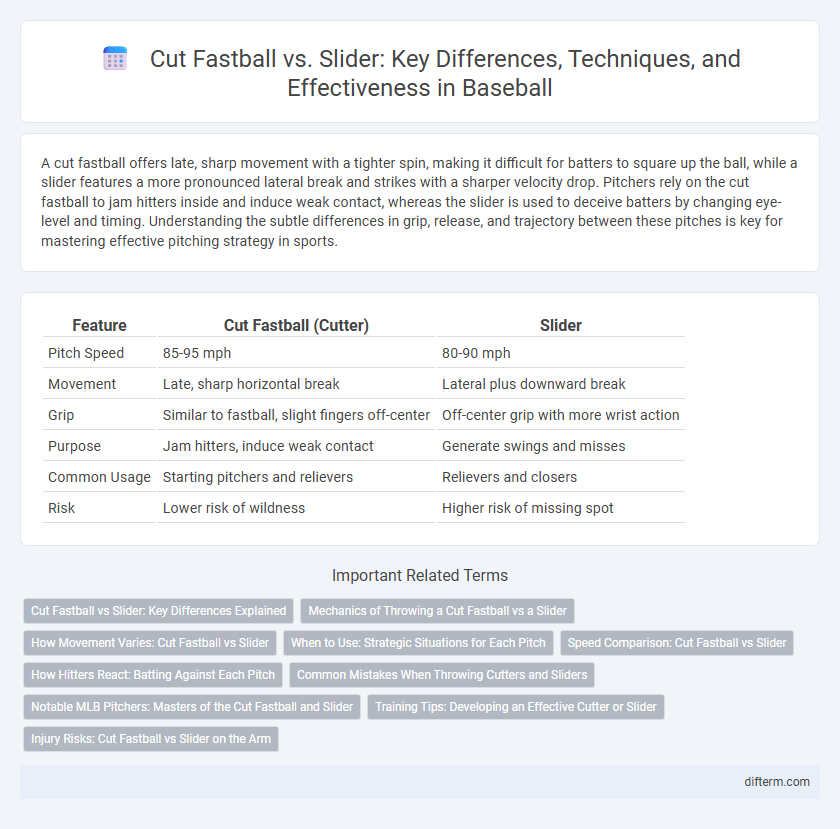A cut fastball offers late, sharp movement with a tighter spin, making it difficult for batters to square up the ball, while a slider features a more pronounced lateral break and strikes with a sharper velocity drop. Pitchers rely on the cut fastball to jam hitters inside and induce weak contact, whereas the slider is used to deceive batters by changing eye-level and timing. Understanding the subtle differences in grip, release, and trajectory between these pitches is key for mastering effective pitching strategy in sports.
Table of Comparison
| Feature | Cut Fastball (Cutter) | Slider |
|---|---|---|
| Pitch Speed | 85-95 mph | 80-90 mph |
| Movement | Late, sharp horizontal break | Lateral plus downward break |
| Grip | Similar to fastball, slight fingers off-center | Off-center grip with more wrist action |
| Purpose | Jam hitters, induce weak contact | Generate swings and misses |
| Common Usage | Starting pitchers and relievers | Relievers and closers |
| Risk | Lower risk of wildness | Higher risk of missing spot |
Cut Fastball vs Slider: Key Differences Explained
The cut fastball, known for its late, sharp movement just before reaching the plate, differs from the slider by its velocity and breaking angle, typically faster and with a more horizontal cut compared to the slider's slower, more diagonal break. Pitchers use the cut fastball to induce weak contact and jam hitters, while the slider aims to deceive batters with its sweeping motion and generate swings and misses. Understanding these key differences helps hitters anticipate pitch behavior and improve their batting approach against each pitch type.
Mechanics of Throwing a Cut Fastball vs a Slider
Throwing a cut fastball involves gripping the baseball with the index and middle fingers slightly off-center, applying pressure on the outer edge to create late lateral movement, while the wrist remains firm and the arm action mirrors a fastball delivery. In contrast, a slider requires a grip with the fingers placed closer together on one side of the ball, combined with a pronated wrist snap upon release to generate tighter, sharper break and reduced velocity compared to a cut fastball. The key mechanical difference lies in wrist position and finger pressure, impacting the ball's spin axis and resulting movement pattern.
How Movement Varies: Cut Fastball vs Slider
The cut fastball exhibits late, sharp horizontal movement with subtle vertical drop, designed to jam hitters and induce weak contact. The slider features more pronounced horizontal and vertical break, with a tighter spin causing it to dive away from the batter's swing path. Pitchers leverage the cut fastball's late glove-side run compared to the slider's sweeping, downward arc to disrupt timing and balance.
When to Use: Strategic Situations for Each Pitch
The Cut Fastball is most effective when a pitcher aims to induce weak contact by jamming hitters or generating ground balls, especially with runners in scoring position. The Slider works best as a strikeout pitch or when ahead in the count, exploiting its sharp break to deceive batters and create swings and misses. Strategic use depends on the batter's strengths and game context, with the cut fastball managing contact and the slider targeting misses.
Speed Comparison: Cut Fastball vs Slider
The cut fastball typically ranges between 85-92 mph, offering slightly higher velocity than the slider, which usually sits around 80-88 mph. Despite the speed difference, the slider generates more lateral movement, making it effective for deception. Pitchers often choose the cut fastball to challenge hitters with speed while using the slider to deceive with sharp breaks.
How Hitters React: Batting Against Each Pitch
Hitters often react differently to a cut fastball and a slider due to the distinct movement patterns and velocities of each pitch. The cut fastball, with its late, subtle horizontal movement, challenges batters by inducing weak contact or jammed hits, requiring quick bat adjustments. In contrast, the slider's sharper, more pronounced break and lower velocity deceive hitters by altering timing and angle, often resulting in swings and misses or off-balance hits.
Common Mistakes When Throwing Cutters and Sliders
Common mistakes when throwing cut fastballs and sliders include improper grip pressure, which can lead to reduced pitch movement and decreased control. Pitchers often fail to maintain consistent arm speed, causing hitters to better predict pitch type. Neglecting to adjust wrist angle during release results in less effective ball spin and diminished lateral break.
Notable MLB Pitchers: Masters of the Cut Fastball and Slider
Notable MLB pitchers known for mastering the cut fastball include Greg Maddux and Kenley Jansen, whose ability to finely control movement confounds hitters consistently. On the slider front, pitchers like Clayton Kershaw and Max Scherzer have elevated the pitch to an art form, blending velocity and sharp break to dominate at the highest level. Both pitches serve as essential weapons in their repertoires, contributing to their sustained success and strikeout prowess.
Training Tips: Developing an Effective Cutter or Slider
To develop an effective cutter or slider, focus on grip adjustment and wrist action during pitching practice. Emphasize consistent release points and finger pressure to create the desired late movement on the ball. Incorporate targeted drills that simulate game scenarios to enhance control and improve deception against hitters.
Injury Risks: Cut Fastball vs Slider on the Arm
The cut fastball and slider both place significant stress on the arm, but the slider generally poses a higher injury risk due to its sharp, lateral snapping motion that increases strain on the elbow's ulnar collateral ligament. Research indicates that pitchers throwing sliders experience more frequent incidents of UCL tears and tendinitis compared to those relying on cut fastballs, which have a more straightforward arm action. Understanding these injury patterns helps pitchers and coaches balance effectiveness with arm health when selecting between these breaking pitches.
Cut Fastball vs Slider Infographic

 difterm.com
difterm.com